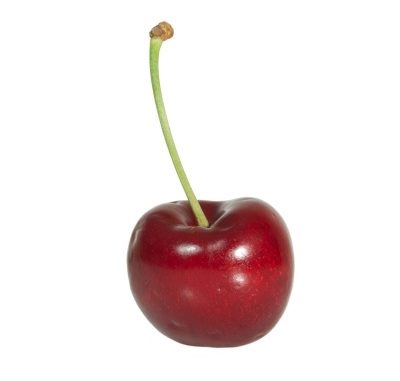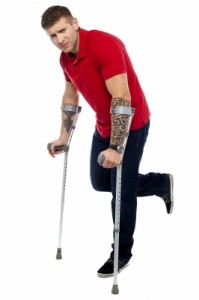
Cherries have long been a popular fruit, not only when fresh but as a processed fruit for desserts and in the USA, marketeers are steadily raising its profile as a homegrown “superfruit” to rival blueberries and cranberries. In the UK, the fruit is also popular and but has a very short season, if it can be picked before the birds eat them. The number of orchards devoted to cherries has steadily declined in the last 50 years as other fruit trees have supplanted them. This is a shame as the fruit produces one of the finest dark red colours known and is a popular flavour in soft drinks even though it is ‘polarising’ in flavour terms with the consumer. However, if many of us are becoming more interested in the provenance of our food, then cherries are a UK crop we should be more interested in.
Cherry colour is provided by the red-purple pigments, anthocyanins and these have been linked in a variety of studies in fruit generally to the health benefits being intensively investigated. The variety I have grown is the Morello which is suitable even for north facing walls and produces a tart culinary cherry. In The USA, the Montmorency cultivar is one of the most popular but I have tasted Bing too which I’ve bought from roadside shacks on the road to Cannon Beach from Portland in Oregon. It’s possible to purchase these varieties in the UK and they arrive around September when the UK harvest has finished so providing an extension to the season.
There is a growing body of evidence that cherries, have a number of health benefits especially with its high antioxidant potential. Tart cherries are promoted for anti-inflammatory benefits -essentially to treat gout and arthritis. Is it the anthocyanins or some other component ? Anthocyanins are found in other fruits but the evidence for their particular benefits is not so well crafted. Again, in the USA, the University of Michigan has been building up the health story by assessing the nutritional benefits from eating cherries with a reduction in the levels for a number of risk factors for heart disease (Seymour et al., 2010; Martin and Burrell, 2010; Martin et al., 2010). These risk factors are total weight, waist line, body fat, inflammation and cholesterol levels. To be most convincing requires positive data from controlled, statistically well-designed, intervention studies in humans. Much of that information was recently reviewed (Bell et al., 2013) and gives an exceptional account how far research has progressed into this particular fruit.
Drinking Cherry Juice Alleviates Muscle Pain
Cherry juice appears to be an important supplement for recovery after sports especially in the alleviation of pain. The research on how tart cherry juice improves recovery after intense exercise is steadily growing. Muscle damage occurs in sports when the muscle fibres are mechanically damaged which produces a rise in reactive oxygen radicals and nitric oxide species. The issue is that muscle damage is commonly sustained during rigorous exercise and post-exercise pain is an indicator of this, and a potential prelude to more serious injury. It is thought that antioxidants might soak up reactive radicals to minimize further damage caused by their release.

Researchers at the Oregon Health & Science University have reported that drinking tart cherry juice whilst training for sustained sports activities such as long distance running meant less muscle pain after exercise compared to those who didn’t drink this juice (Kuehl et al., 2009). In this study, they had a reasonably large number of healthy adults, sixty in total, aged between 18 and 50 who drank 10.5 ounces of 100% cv. Montmorency cherry juice (CHERRish™). One group drank the cherry juice twice a day whilst the other used another fruit juice, for 7 days before and on the day of a long-distance relay race. Using a self-reporting method, and ranking muscle pain from 0 to 10, the participants who drank cherry juice had a statistically significant ‘2 point’ lower pain level in their muscles than those who hadn’t. The adults who drank the juice reported statistically less significant pain in their muscles following the race compared to those who drank the equivalent volume of another fruit juice.
Another intriguing study with runners of the London Marathon showed that drinking Montmorency cherry juice helped them recover quicker than the placebo controlled group (Howatson et al., 2009). The variety used, Montmorency has a high level of polyphenols and anthocyanins with a high antioxidant potential. Researchers at Northumbria University looked at recovery in 20 athletes who loaded up with either a cherry juice blend or a placebo twice daily for 5 days before taking part in the race and then for two days afterwards. They looked at the markers of muscle damage such as creatine kinase levels and lactate dehydrogenase activity, feelings of muscle soreness and recovery of isometric strength. Other measures included inflammation (interleukin-6, C-reactive protein (CRP) and uric acid), total antioxidant potential and a TBARS measure. They concluded there was no statistical difference in the levels of the muscle damage markers but the marker levels of inflammation and of oxidative damage were lower in the juice supplemented group. Although supplementing does not prevent muscle damage, the authors suggested that cherry juice alleviated some of the effects of muscle damage.
Cyclists have also been assessed for soreness. Bell et al. (2014) demonstrated that feeding Montmorency cherries to 16 well-trained, male cyclists helped them recover from muscle soreness. In this study, the cyclists were either given twice a day for seven days, 30ml (1 oz.) cherry juice concentrate mixed with water equivalent to 90 whole cherries per serving or the calorie-matched placebo. The cyclists performed a three-day simulated race. Drinking the cherry juice- the format is probably significant, helped he cyclists suffer less from inflammation and muscle soreness compared to the placebo group.
The study by Bowtell et al., (2011) supports this view above. Bowtell et al., demonstrated that drinking cherry juice helped recovery after intense exercise following a bout of isometric muscle training. In this study, the participants drank CherryActive® which is available as a concentrate. In the study, 10 healthy well-trained athletes drank 1 oz of this cherry’s juice twice daily for loading purposes, 7 days before each embarked on intense strength training in two trials of 10 sets of 10 single-leg knee extensions at 80% one-repetition maximum. They then drank cherry juice for 2 days after. They compared performance with a control group who drank an isoenergetic juice concentrate without the same level of antioxidants present in a cross-over experimental design. A number of markers for muscle damage and recovery were measured using venous blood samples, which were collected at defined time points, and the serum was analyzed for high-sensitivity C-reactive protein, nitrotyrosine, total antioxidant capacity, creatine kinase (CK) activity and protein carbonyls (PC).
The researchers’ conclusions from this study were that the group drinking the cherry juice returned to about 90% of their normal muscle force after 24 hours and had faster recovery compared to 85% in the control group. The researchers concluded this was ‘perhaps owing to the attenuation of the oxidative damage induced by the damaging exercise’ and was viewed as a significant result in the recovery of the athletes. There was no reference to measurement of pain in the study to reinforce the more subjective measures in the 2009 papers mentioned. It would be interesting to see if the more rapid return was achieved with other high polyphenol containing juices and in different exercise formats.
The perceived reduction in muscle pain could be related to reduction in inflammation, arthritis and other joint pains for which there is some evidence. There is also some evidence that it may help alleviate fibromyalgia which is a chronic pain complaint (Jones et al., 2009). Further research probably needs to be directed at whether there is a pronounced difference between tart and sweet cherries, the cultivar, the anthocyanin content and even the type of anthocyanin. There is certainly a case for pinpointing the mechanisms behind the findings but it is a good indication that cherry juice consumption offers the athlete and all of us much more than just a richly coloured drink with a distinctive and pleasant taste.
References
Bell, P. G., Walshe, I. H., Davison, G. W., Stevenson, E., & Howatson, G. (2014). Montmorency Cherries Reduce the Oxidative Stress and Inflammatory Responses to Repeated Days High-Intensity Stochastic Cycling. Nutrients, 6(2), pp. 829-843.
Bowtell, J. L., Sumners, D. P., Dyer, A., Fox, P., Mileva, K. N. (2011) Montmorency Cherry Juice Reduces Muscle Damage Caused by Intensive Strength Exercise. Med. Sci. Sports Exerc. 43(8) pp 1544-1551
Howatson, G., McHugh, M. P., Hill, J. A., Brouner, J., Jewell, A. P., van Someren, K. A., et al. (2009). Influence of tart cherry juice on indices of recovery following marathon running. Scand. J. Med. Sci. Sports, 20(6), pp. 843-852.
Kuehl, K.S., Chestnutt, J., Elliot, D.L., Lilley, C. (2009) Efficacy of tart cherry juice in reducing muscle pain after strenuous exercise. American College of Sports Medicine. paper 851. May.
Jones, K.D., Elliot, D.L., Kuehl, K.S., Dulacki, K. (2009) Tart cherry juice for fibromyalgia: new testing paradigm and subgroup benefits. American College of Sports Medicine. paper 852. May.
Martin, K.R., Burrell L. (2010) 100% tart cherry juice reduces pro-inflammatory biomarkers in overweight and obese subjects. FASEB Journal. 24 pp. 724.15.
___________., Bopp, J., Neupane, S., Vega-Lopez. V. (2010) 100% tart cherry juice reduces plasma triglycerides and CVD risk in overweight and obese subjects. FASEB Journal 24 pp. 722.14
Seymour, E.M., Urcuyo-Llanes, D., Bolling S.F., Bennink, M.R. (2010) Tart cherry intake reduces plasma and tissue inflammation in obesity-prone rats. FASEB Journal 24 pp. 335.1.
Leave a Reply